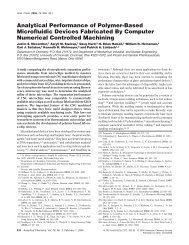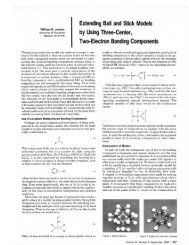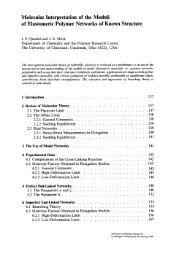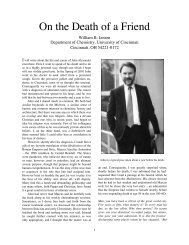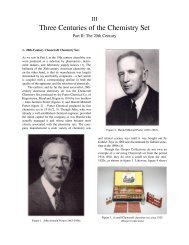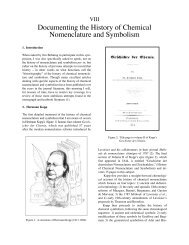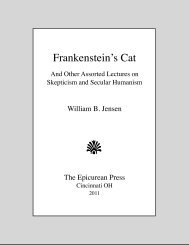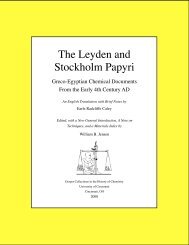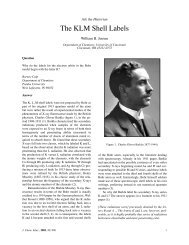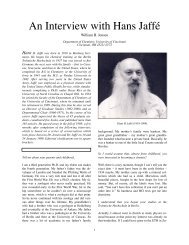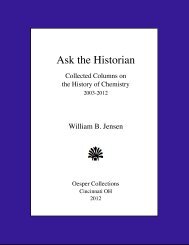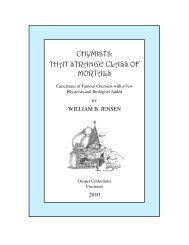135. Hypervalence.pdf - University of Cincinnati
135. Hypervalence.pdf - University of Cincinnati
135. Hypervalence.pdf - University of Cincinnati
You also want an ePaper? Increase the reach of your titles
YUMPU automatically turns print PDFs into web optimized ePapers that Google loves.
Question<br />
What is the origin <strong>of</strong> the term “hypervalent”?<br />
Henry A. Bent<br />
5816 Solway Street<br />
Pittsburgh, PA 15217<br />
Answer<br />
Ask the Historian<br />
The Origin <strong>of</strong> the Term “Hypervalent”<br />
The term hypervalent was first introduced by Jeremy<br />
Musher in 1969 to describe compounds and complex<br />
ions <strong>of</strong> the heavier main-block elements (period 3 and<br />
beyond) in which the use <strong>of</strong> traditional Lewis 2c-2e<br />
covalent bonds requires the additional assumption <strong>of</strong><br />
“octet expansion” for the central atom (e.g. PCl5, SiF6 2-<br />
etc.) (1). The debate over how to rationalize the bonding<br />
in these species goes back to the very origins <strong>of</strong> the<br />
electronic theory <strong>of</strong> the covalent bond and ultimately<br />
revolves around the question <strong>of</strong> whether the 2c-2e<br />
bond or the octet rule is the more rigorous bonding<br />
principle. In the 1920s a vigorous debate over this issue<br />
was carried on between G. N. Lewis and Irving<br />
Langmuir, with the former opting for octet expansion<br />
and the dominance <strong>of</strong> the 2c-2e bond (2) and the latter<br />
for the dominance <strong>of</strong> the octet rule, thus requiring the<br />
assumption that the bonding in hypervalent species<br />
was ionic rather than covalent (3).<br />
In the late 1920s and early 1930s, Samuel Sugden,<br />
on the basis <strong>of</strong> parachor measurements, argued for the<br />
existence <strong>of</strong> 2c-1e covalent bonds and showed how<br />
they could be used, in conjunction with traditional 2c-<br />
2e covalent bonds, to rationalize the bonding in hypervalent<br />
species without the necessity <strong>of</strong> either violating<br />
the octet rule or invoking ionic bonding, but his suggestions<br />
were not widely accepted (4). Ironically, in the<br />
1940s and 1950s essentially the same concept was invoked<br />
by Robert Rundle (figure 1) (5) and George Pimentel<br />
(6) via MO theory and their introduction <strong>of</strong> the<br />
so-called 3c-4e bond (<strong>of</strong> which only two <strong>of</strong> the four<br />
electrons are actually bonding and correspond to two<br />
collinear 2c-1e bonds in Sugden’s sense, whereas the<br />
remaining two electrons correspond to nonbonding or<br />
weakly antibonding electrons concentrated on the outer<br />
periphery <strong>of</strong> the molecule).<br />
William B. Jensen<br />
Department <strong>of</strong> Chemistry, <strong>University</strong> <strong>of</strong> <strong>Cincinnati</strong><br />
<strong>Cincinnati</strong>, OH 45221-0172<br />
Figure 1. Robert Eugene Rundle (1915-1963).<br />
In the 1960s and 1970s an extensive literature developed,<br />
based on empirical bond-length and bond-<br />
angle correlations, which argued for octet expansion,<br />
not only in the case <strong>of</strong> hypervalent species but also for<br />
purposes <strong>of</strong> invoking multiple bond character, via<br />
backbonding, in such apparently normal octet species<br />
as N(SiH3)3, S4N4 and ClO4 - (7). At about the same<br />
time, quantitative MO calculations on hypervalent species<br />
began to appear which to tended to support the<br />
opposite conclusion and to largely confirm the Rundle-<br />
Pimental picture <strong>of</strong> the bonding in these species (8).<br />
This debate continued throughout the 1980s and<br />
1990s, when it was fueled by both the discovery <strong>of</strong> an<br />
increasing number <strong>of</strong> hypervalent species for the second<br />
row elements, for which outer d-orbital participation<br />
seemed even less likely (9), and by increasingly<br />
sophisticated calculations, the majority <strong>of</strong> which again<br />
seemed to support the dominance <strong>of</strong> the octet rule and<br />
the validity <strong>of</strong> the Rundle-Pimentel model (10), with<br />
J. Chem. Educ., 2006, 83, 1751-1752 1
the provision that it was necessary to carefully distinguish<br />
between the use <strong>of</strong> “d-functions” to improve<br />
computational basis sets, on the one hand, and the use<br />
<strong>of</strong> “d-orbitals” to increase the electron population in<br />
the bonds, on the other (11).<br />
One additional consequence <strong>of</strong> this latter phase<br />
was that the appropriateness <strong>of</strong> Musher’s term “hypervalent”<br />
also came under attack. Indeed, in the article in<br />
which Musher originally introduced the term, he essentially<br />
rejected octet expansion and opted instead for the<br />
Rundle-Pimental model, thus implying either that hypervalent<br />
species were not truly hypervalent or that the<br />
term simply donated a species that required a bonding<br />
scheme other than the traditional Lewis 2c-2e model.<br />
In 1984 Paul von Rague van Schleyer suggested the<br />
use <strong>of</strong> the term hypercoordinate, rather than hypervalent,<br />
to describe such species, as this provided an empirical<br />
characterization <strong>of</strong> their experimentally observed<br />
molecular structures without the necessity <strong>of</strong><br />
having to endorse a particular view concerning the<br />
theoretical description <strong>of</strong> their electronic bonding (12).<br />
Despite the cogency <strong>of</strong> this suggestion, there are<br />
still dissenters (13), and despite the nearly unanimous<br />
conclusions <strong>of</strong> theoretical studies that the octet rule is a<br />
valid first approximation for the entire main-block and<br />
that it is the traditional Lewis 2c-2e model <strong>of</strong> covalent<br />
bonding which requires modification, octet expansion<br />
and the 2c-2e bond still reign supreme in introductory<br />
chemistry textbooks, in large part because <strong>of</strong> the widespread<br />
belief that they are a necessary component <strong>of</strong><br />
the highly successful VSEPR model for the prediction<br />
<strong>of</strong> molecular geometries (14).<br />
Literature Cited<br />
1. J. L. Musher, “The Chemistry <strong>of</strong> Hypervalent Molecules,”<br />
Angew. Chem. Int. Ed., 1969, 8, 54-68.<br />
2. G. N. Lewis, Valence and the Structure <strong>of</strong> Atoms and<br />
Molecules, The Chemical Catalog Co: New York, NY, 1923,<br />
Chapter 8.<br />
3. I. Langmuir, “Types <strong>of</strong> Valence,” Science, 1921, 54,<br />
59-67.<br />
4. S. Sugden, The Parachor and Valency, Knopf: New<br />
York, NY, 1930, Chapter 6.<br />
WILLIAM B. JENSEN<br />
5. R. E. Rundle, “Electron Deficient Compounds,” J.<br />
Am. Chem. Soc., 1947, 69, 1327- 1331.<br />
6. G. Pimentel, “The Bonding <strong>of</strong> Trihalide and Bifluoride<br />
Ions by the Molecular Orbital Method,” J. Chem. Phys.,<br />
1951, 19, 446-448.<br />
7. For convenient summaries <strong>of</strong> this literature, see K. A.<br />
R. Mitchell, “The Use <strong>of</strong> Outer d Orbitals in Bonding,”<br />
Chem. Rev., 1969, 69, 157-178; and L. D. Petit, “Multiple<br />
Bonding and Back-Coordination in Inorganic Compounds,”<br />
Quart. Rev., 1971, 25, 1-29.<br />
8. For period overviews, see C. A. Coulson, “d-Orbitals<br />
in Chemical Bonding,” in W. O. Mulligen, Ed., Proceedings<br />
<strong>of</strong> the Robert A. Welch Foundation Conferences on Chemical<br />
Research. XVI. Theoretical Chemistry, Houston, TX, 1972,<br />
Chap. 3, and T. B. Brill, “d Orbitals in Main Group Elements,”<br />
J. Chem. Educ., 1973, 50, 392-396.<br />
9. J. C. Martin, “‘Frozen’ Transition States: Pentavalent<br />
Carbon et al.”, Science, 1983, 221, 509-514.<br />
10. For overviews, see W. Kutzelnigg, “Chemical Bonding<br />
in Higher Main Group Elements,” Angew. Chem. Int. Ed.,<br />
1984, 23, 272-295 and F. Weinhold, C. Landis, Valency and<br />
Bonding, Cambridge <strong>University</strong> Press: Cambridge, 2005,<br />
Chap, 3.<br />
11. E. Magnusson, “Hypercoordinate Molecules <strong>of</strong><br />
Second-Row Elements: d Functions or d-Orbitals?,” J. Am.<br />
Chem. Soc., 1990, 112, 7940-7951.<br />
12. P. von Rague van Schleyer, “Hypervalent Compounds,”<br />
Chem. Eng. News, 1984, 62, 4. Smith has recently<br />
documented a widespread confusion among chemists over<br />
the use <strong>of</strong> such terms as valence and coordination number,<br />
see D. W. Smith “Valence, Covalence, <strong>Hypervalence</strong>, and<br />
Coordination Number,” J. Chem. Educ., 2008, 82, 1202-<br />
1204.<br />
13. J. C. Martin, “More Clarification,” Chem. Eng. News,<br />
1984, 62, 4, 70.<br />
14. R. J. Gillespie, E. A. Robinson, “<strong>Hypervalence</strong> and<br />
the Octet Rule,” Inorg. Chem., 1995, 34, 978-979.<br />
Do you have a question about the historical origins <strong>of</strong><br />
a symbol, name, concept or experimental procedure<br />
used in your teaching? Address them to Dr. William B.<br />
Jensen, Oesper Collections in the History <strong>of</strong> Chemistry,<br />
Department <strong>of</strong> Chemistry, <strong>University</strong> <strong>of</strong> <strong>Cincinnati</strong>,<br />
<strong>Cincinnati</strong>, OH 45221-0172 or e-mail them to<br />
jensenwb@ucmail.uc.edu<br />
2 J. Chem. Educ., 2006, 83, 1751-1752



